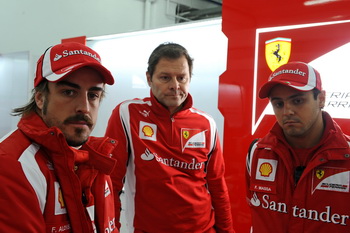 |
|
"We know that we have a good basis on which
to work on the mechanical side," said
Ferrari Technical Director Aldo Costa
(centre) at the
end of the test, "while when it comes to
aerodynamics, we will not see the final
version of the F150 until we get to
Bahrain." |
|
|
|
|
Three days of testing,
the very first of the season, are not enough to produce
concrete evidence regarding the effectiveness of the
work done by the teams on their new cars. Scuderia
Ferrari was certainly not the exception to this rule, as
was confirmed by Technical Director Aldo Costa, during a
brief meeting with the media at the “Ricardo Tormo”
circuit at Cheste.
“There are still so many questions hanging in the air
that it’s impossible to have a realistic view of the
situation, starting with the tyres,” said Costa. “In the
very short time at its disposal, Pirelli has done a
great job of bringing tyres here that, from a
construction point of view, which effectively means in
terms of reliability, are on the right track. And now
they are developing the compounds, which according to
the Milan-based company, will now evolve from there.
Then it is up to us to work on the mechanical set-up of
the car to improve the tyre behaviour.”
Inevitably, the press wanted an opinion as to how this
first run of tests had gone. “Looking at our own work in
isolation, we can be pleased with what we have done,”
said the engineer from Parma. “We are more or less where
we expected, even if there is still work to do to have a
full understanding of the handling of the car,
especially when it comes to aerodynamics and tyres.
However, if we had to say where we are compared to the
others, then it would not be possible to give a precise
answer. I’m not saying we’re stumbling around in the
dark, but almost, given how many unknown factors are in
play here. Then, you have to remember, this is only the
start: for our part, we know that between now and Jerez
we have a good basis on which to work on the mechanical
side, while when it comes to aerodynamics, we will not
see the final version of the F150 until we get to
Bahrain. And I think that’s pretty much the case for
everyone.”
Today, Felipe lost around four hours of track time
because of a reliability problem and Costa provided this
explanation as to its cause: “It was a silly thing
really: a pipe came undone and the oil that escaped
ended up on the exhausts and tyres. That led to the spin
and the small fire which caused the damage that led to a
long stop in the garage. It was a shame, as until this
point, everything had gone smoothly.”
Another topic that was at the centre of attention was
the moveable rear wing, even if the precise details
about how this aid can be used in the races have not
been finalised. “The FIA has informed us that the
operation of the rear wing can be effected by the
following car, six hundred metres from the end of the
straight, in the case of the gap between the two cars
being under a certain time, prior to going into the
final corner leading onto the straight in question,”
continued the Maranello team’s technical director.
“Further information, going into detail and the various
scenarios still has to be clarified and it’s been said
that, at least in the early part of the season, the use
of the moveable wing will not be allowed in the case of
a wet race. Then it will be a case of seeing how things
go in the race to understand how to proceed.”
As an experienced engineer, Costa had spotted some
original ideas on some cars: “We definitely saw some
pretty extreme things such as the exhausts on the
Renault and the gearbox on the Williams,” said Aldo.
“There are so many irons in the fire, from our side too,
so it will be interesting to see how it all turns out.
We are pleased with the work we have done. What counts
when it comes to having a quick car is not so much to be
innovative, but more a case of being able to have enough
performance to deliver the lap time.”
|
|
|